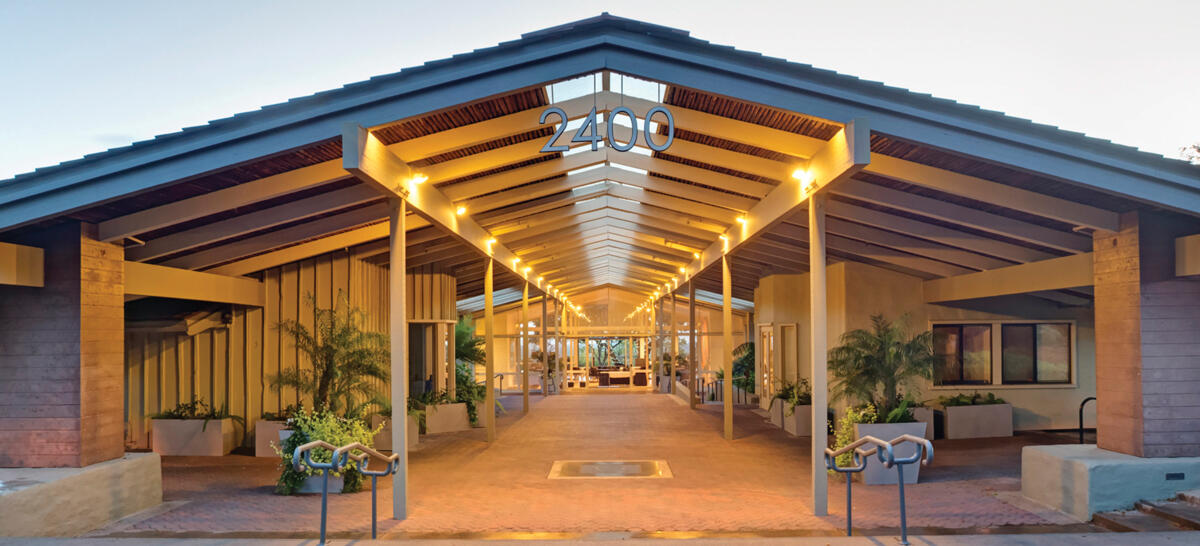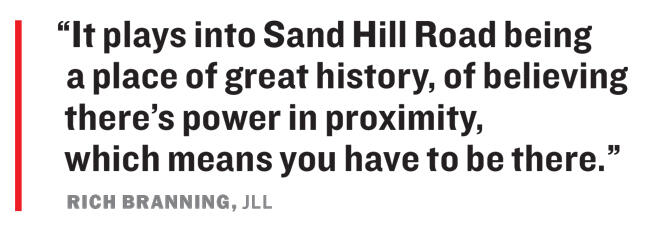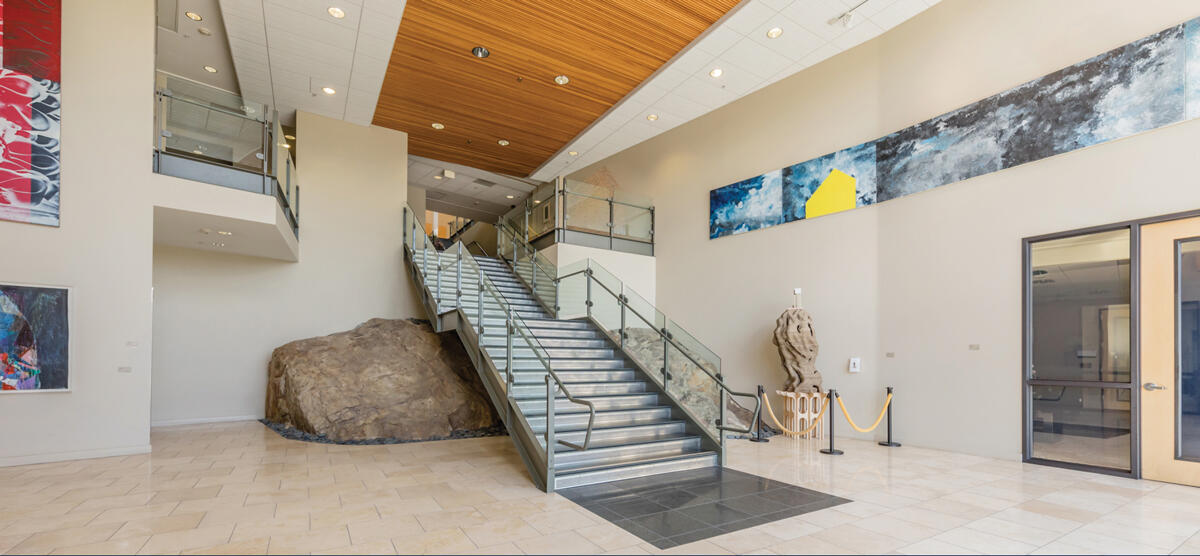Trending
Sand Hill Road reckons with its future
Landlords of the iconic Silicon Valley office strip rethink strategies in remote-work era

There are only a handful of streets across the U.S. that are synonymous with entire industries. Wall Street and finance. Madison Avenue and advertising. K Street and politics.
In Menlo Park, California, it’s Sand Hill Road and venture capital. When an upstart VC firm named Kleiner Perkins established its headquarters on the 5.6-mile stretch of Silicon Valley roadway in 1972, few could have predicted that the area would eventually become the center of the tech-funding universe.
Almost every prominent Silicon Valley company — Google, Facebook and Apple among them — has received early-stage backing from venture capitalists on Sand Hill Road. Wikipedia lists almost 50 VC firms along a one-mile strip connecting Stanford University with Interstate 280, including industry leaders such as Kleiner Perkins, Sequoia Capital and Andreessen Horowitz, also known as a16z.
In a way, the area has beaten the odds to become one of the world’s most expensive office submarkets. Its building base is about 1.2 million square feet of mainly low-rise, woody walk-ups, most of them built in the 1970s and ’80s and situated between trees, rosemary plants and parking lots.
Yet average asking rents for Class A space — the only type available on Sand Hill Road — were $10.66 per square foot per month at the end of last quarter, highest in the Bay Area and pricier than the central business district in Greenwich, Connecticut, Manhattan’s Park Avenue and other top-tier office markets across the country, according to Newmark data.
Sand Hill Road landlords have been able to charge rents that would normally be prohibitively expensive because their properties offer something besides proximity to high-priced housing and a bucolic setting: the opportunity to establish cachet simply through an address, which tells the rest of the world that “we know you’re somebody,” as one broker put it.
But a two-year experiment with remote work has executives — including many of tech’s most prominent leaders — challenging the notion that a physical workplace is essential to a healthy business. Office corridors across the country are being tested, and Sand Hill Road is no exception.
The dominoes, it seems, have already begun to fall. Last month, Andreessen Horowitz, one of the world’s most prominent and influential venture capital firms, said its headquarters will no longer be located on Sand Hill Road — or anywhere in the physical world.
“Our headquarters will be in the cloud,” co-founder Ben Horowitz wrote in a July 21 blog post, noting that the success of the work-from-anywhere model “is profoundly weakening the Silicon Valley network effect.”
Andreessen Horowitz is keeping its Sand Hill and San Francisco offices and opening new ones in Miami, New York and Santa Monica, which will allow the firm to “materialize physically on command” while mostly operating virtually, Horowitz wrote. But the decision reinforces the notion that being headquartered on Sand Hill, or even having a physical address, isn’t as important as it used to be.
Vacancies on the iconic roadway topped 15 percent at the end of 2020, the highest since the aftermath of the Great Recession, Newmark data show. Several new Class A office projects near Caltrain are taking shape across the Bay Area, one of which is touting itself as “Sand Hill Road 2.0” and has already lured a prominent venture capital firm away from the original.
All of this poses a question Sand Hill Road office landlords have been dismissing for the better part of a decade: Are the iconic strip’s best days behind it? To them, the road’s demise has, once again, been greatly exaggerated. DivcoWest, the area’s largest office owner, says demand is at its highest in a decade. Vacancies dropped each quarter last year and stood below 12 percent as of June, according to Newmark data.
But the enduring adoption of remote or hybrid work arrangements offers a sobering moment of reflection, as does Andreessen Horowitz’s decision and its potential ramifications for the road’s other tenants. If a16z’s first employee, Scott Kupor, published his bestselling how-to guide for founding a venture-backed startup in 2029, rather than 2019, would it still be titled “Secrets of Sand Hill Road”?

Faced with that type of uncomfortable question, the road’s dozen or so office landlords, including not only DivcoWest but Clarion Partners, Invesco Real Estate and Stanford University, aren’t sitting idle. They’re investing in upgrades, the biggest of which involves creating high-end spaces that require little capital or build-out time from prospective tenants, according to CBRE’s Todd Husak. They’re adding gyms, fitness classes and other amenities employers would’ve had to seek elsewhere in the past.
“I’d like to think that demand over the next few years will be sustained as people want more outdoor space, higher-end amenities, some of the things that Sand Hill has inherently, which is the location,” DivcoWest’s Gregg Walker said.
Subtle elegance
What is now a mile-long strip of low-slung offices was once a hill covered with briars and weeds. As the story goes, Tom Ford, founder of Ford Land Company and Stanford’s former head of real estate, was driving with Grant Heidrich, a longtime partner at Mayfield Fund, one of Silicon Valley’s oldest VC firms. Ford pointed to the weed-infested hill and told Heidrich, “I have a vision. This will become one of the most sought-after places to work, because it’s right between San Jose and San Francisco and has access to Stanford.”
Getting Kleiner Perkins to sign onto Ford’s first office project on the road was key to making his vision a reality. Mayfield and Institutional Venture Partners followed Kleiner to the area, and by the end of the 1990s, Ford had a waiting list of over a dozen firms seeking space in one of his 12 buildings on Sand Hill Road. Demand far exceeded supply, and lease negotiations were brutally simple: Ford would name a price, and the tenant would pay it. Lease documents were often structured as five-page gentleman’s agreements, Fortune reported in 1998.
One of Ford’s pitches to tenants was that the road was much closer to where they lived than San Francisco. As firms began decamping to Sand Hill, a collaborative culture developed.
“It wasn’t just one VC giving a small startup all the money,” said Gary Wimmer, general partner at the late developer’s firm. “They were collaborating and co-investing together. They found that being on Sand Hill Road and close by was an opportunity to continue collaborating, and they liked that.”
If all of this sounds like something from a bygone era, that’s because it is. Walking through one of the road’s office complexes is like taking a trip back in time to when parts of Interstate 280 were still dirt roads and wood-frame workplaces were in vogue. One reason the road’s unassuming buildings have maintained their appeal for so long is that they provide the physical equivalent to the understated, collegial nature of Silicon Valley’s venture capital culture, in which blazers and jeans are preferred to suits and ties and employees at different firms can meet up for drinks or Michelin-starred fare at the luxury Rosewood Sand Hill hotel.
“Anyone that comes here is fascinated with it, but it’s not overpowering or ostentatious,” Pete Thomas, co-founder of VC firm ATA Ventures, once said. “It’s subtle elegance.”
Of course, buildings deemed elegant by some can look old and tired to others, including Presidio Bay Ventures’ K. Cyrus Sanandaji. The San Francisco-based developer seeks to compete with the iconic street through Springline, a mixed-use project 3 miles away that includes 200,000 square feet of Class A offices across two buildings, as well as apartments and 10 restaurants and cafes.
Springline has so far signed five venture capital firms to its tenant roster, one of which, Menlo Ventures, is shifting its headquarters there after spending over two decades on Sand Hill Road. Sanandaji believes the latter area’s lore has helped it overcome being an “amenities island” with outdated, poorly insulated office structures that, among other shortcomings, aren’t in the most transit-friendly location. Presidio Bay’s project serves to “make the decision a relatively easy one for firms that realize there’s a significant advantage to being at Springline versus Sand Hill Road,” he said in April.
An indoor-outdoor atmosphere
DivcoWest’s January 2020 purchase of two of Sand Hill Road’s marquee properties from Ford Land Company shows that timing is everything in real estate. The buyer already owned a nine-building, 234,000-square-foot campus on Sand Hill when it added two more totaling 319,000 square feet. The cost: $610 million, or about $1,912 a square foot, more than $100 higher than what Alameda Realty Partners paid in the area’s previous significant office transaction, in 2018. With the deal, Divco owned 44 percent of Sand Hill Road’s office market, making it its single largest landlord.
Two months after the sale closed, county governments in the Bay Area issued shelter-in-place orders. Most lease negotiations ground to a halt, and Sand Hill, like every other office submarket in the region, saw vacancies jump. Although they’ve since come down, the road hasn’t seen any major investment sales during the pandemic. Asking rents, meanwhile, have ticked up slightly, averaging $10.66 a square foot a month at the end of June, up from $10.10 two years ago, according to Newmark.
DivcoWest didn’t have to wait long for the market to start rebounding. Last year, the firm signed just under 40 leases there, about three times as many as in 2020, according to Walker.

A look inside one of the office buildings in DivcoWest’s “Sand Hill Collection,” three campuses it owns on Menlo Park’s Sand Hill Road
“Some of the things folks are looking for now in a post-pandemic world are indoor-outdoor space, which our project has a lot of,” he said.
DivcoWest has spent the past three years renovating and expanding amenities for its buildings on the road, which are spread across three campuses and branded the “Sand Hill Collection.” Additions include a pickleball court, a firepit and an outdoor deck on one campus, and new green space and seating areas equipped with Wi-Fi to replace a handful of parking spaces on another, Walker said.
A farm-to-table restaurant named Sand Hill Kitchen opened on one of the campuses in mid-May. It will take more than $15 lunch salads to make the strip more enticing for office tenants, but upgrades like these could help.
“Divco’s idea wasn’t that Sand Hill Road needed a rethink,” said Newmark’s Christian Prelle, who’s leading a team of brokers to market the Sand Hill Collection for lease. “As with any suburban project, there’s a mind toward an enhancement and a flexibility toward change and progress.”
Prelle said demand for office properties on Sand Hill is the highest he’s seen since he started marketing them in 2012, with much of it driven by companies looking to expand their footprints and lateral moves.
Some venture capital firms “probably hired a lot during Covid to accommodate work that needed to be done on these new funds they’re raising,” Prelle said. “Now that they’re returning to the office, or at least thinking about returning, they have to accommodate the folks they hired that perhaps were working from home.”
Serendipitous ‘bump-ins’
CBRE’s Husak has had some clients lease office space on Sand Hill Road this year, and others are now looking at the area as an option, he said. “Plug-and-play” sublease options — space that requires little to no tenant improvements — have received the most attention, he said.
The amount of vacant sublease space on the road declined to about 26,000 square feet at the end of last quarter, from nearly 45,000 square feet the year before, according to Newmark. While a 19,000-square-foot change sounds small, context matters: Any lease larger than 10,000 square feet is considered big for Sand Hill.
“Where Sand Hill has really changed is that ownership has invested capital into providing high-end, market-ready spaces that require little investments of capital and time from potential tenants,” Husak wrote in an email.
The area “has been able to offer more amenities such as gyms, restaurants, meeting areas and fitness classes, which many tenants have had to look elsewhere for in the past,” he added.
All of this bodes well for vacancy rates, which Rich Branning of JLL believes could drop below 10 percent in the short term. Branning and JLL have represented almost 20 venture capital and private equity firms in office deals on Sand Hill over the years, including IVP, Andreessen Horowitz and Mayfield.
Branning said he’s heard about a number of large VC firms with offices on Sand Hill Road and in San Francisco that are reviewing their footprints and working on expanding in both locations.
“The feedback I’m getting says that the private equity firms, the financial companies, the venture capitalists, they believe they need to be in the office to do their work,” he said. “It also plays into Sand Hill Road being a place of great history, of believing there’s power in proximity, of serendipitous ‘bump-ins’ that get you into deal flow, which means you have to be there.”




